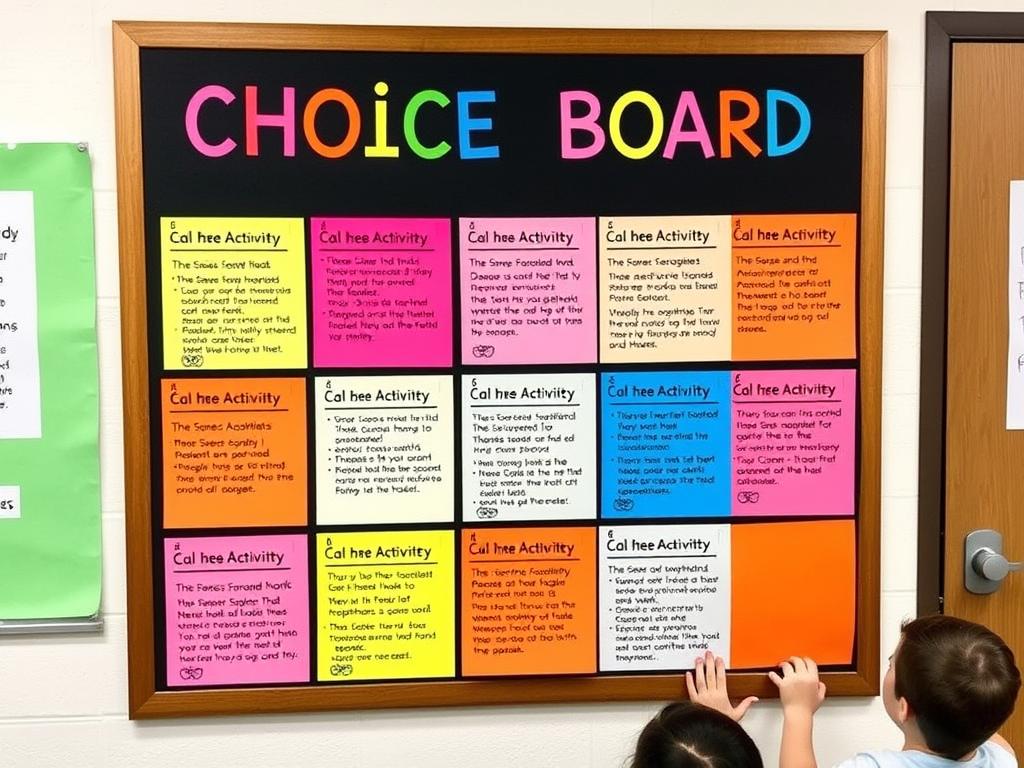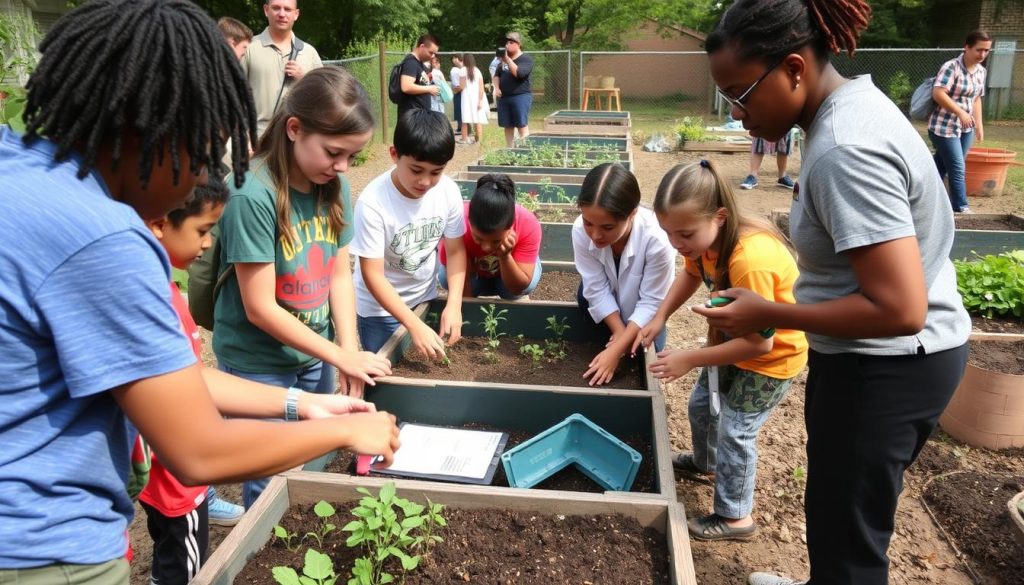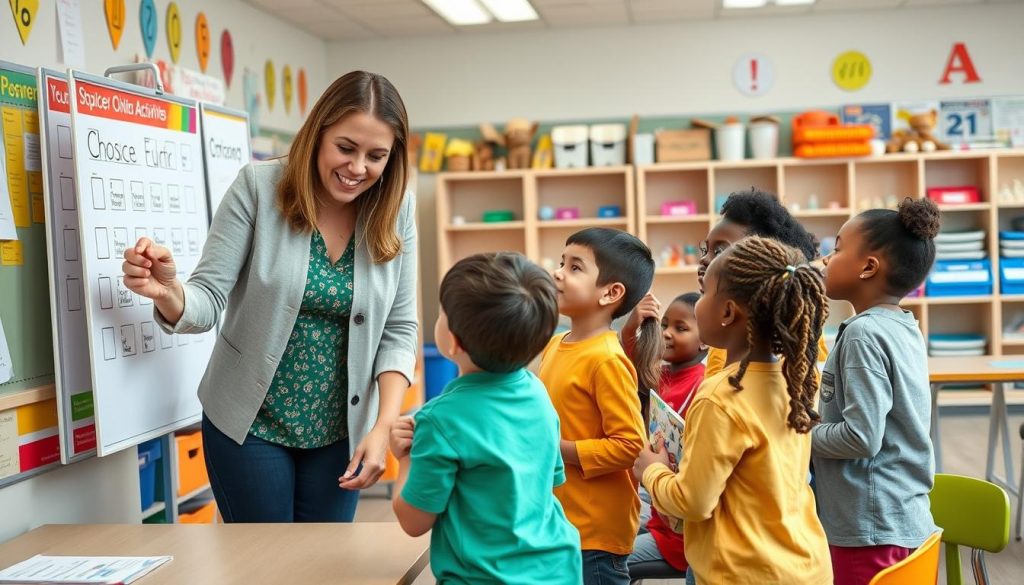Why Student Choice Matters: Foundational Strategies for Engaged Learning
Student choice isn’t just a trendy educational concept—it’s backed by substantial research showing that when students have input into their learning process, they demonstrate higher levels of motivation, deeper content understanding, and greater academic success. As teachers, developing the teacher skills necessary to effectively implement choice requires understanding both the “why” and the “how” of this approach.
Student choice creates ownership and investment in the learning process
When students have agency in their education, several important things happen:
- Increased intrinsic motivation as students pursue topics of personal interest
- Greater persistence when facing challenges because students feel invested
- Development of critical decision-making skills that extend beyond the classroom
- Improved classroom culture as students feel their voices matter
- Enhanced teacher-student relationships built on mutual respect
According to a study published in the Journal of Educational Research, classrooms that incorporate student choice show significantly higher engagement levels compared to those with more rigid structures. The teacher skills required to facilitate this kind of learning environment include flexibility, active listening, and the ability to scaffold choices appropriately for different age groups.
Ready to transform your teaching approach?
Discover how to implement effective student choice strategies in your classroom with our comprehensive professional development resources.
Types of Student Choice: Diverse Strategies for Engaged Learning
Implementing student choice doesn’t mean giving students complete freedom without structure. In fact, the most effective teacher skills involve knowing how to provide appropriate choices within well-designed frameworks. Let’s explore the different types of choice you can incorporate into your lesson plans:
Content Choice
Content choice allows students to select what they learn within the boundaries of curriculum standards. This type of choice helps students connect with material that resonates with their personal interests.
Examples of Content Choice:
- Allowing students to select which historical figure to research within a specific time period
- Offering a range of texts that address the same reading standards but cover different topics
- Providing options for science experiments that demonstrate the same principle
Process Choice
Process choice focuses on how students learn, giving them options for the methods they use to acquire and process information. This approach recognizes that students have different learning preferences and strengths.
Examples of Process Choice:
- Offering options to work individually, in pairs, or small groups
- Providing different research methods (interviews, online research, books)
- Allowing students to choose between taking notes, creating mind maps, or recording audio summaries
Product Choice
Product choice gives students options for how they demonstrate their learning. This type of choice allows students to showcase their knowledge through their strengths and interests.

Examples of Product Choice:
- Creating a video, writing a paper, or designing a presentation
- Building a model, drawing a diagram, or composing a song
- Developing a website, writing a story, or creating an infographic
Environmental Choice
Environmental choice involves giving students options about where and when they learn. This type of choice acknowledges that physical environment affects learning and concentration.
Examples of Environmental Choice:
- Flexible seating options (standing desks, floor cushions, traditional desks)
- Choice of working in quiet zones or collaborative spaces
- Options for headphones during independent work time
Developing these teacher skills for implementing different types of choice takes practice, but the impact on student engagement makes it worthwhile. Remember that the goal is to provide meaningful choices that support learning objectives, not simply to offer options for the sake of choice.
Looking for more specific guidance on implementing student choice in your classroom? Our comprehensive guide on providing student choice offers step-by-step instructions and ready-to-use templates.
Implementing Choice Boards: Practical Strategies for Engaged Learning
Choice boards are one of the most versatile and effective tools for incorporating student choice into your classroom. These organized menus of learning options help develop important teacher skills while providing students with structured autonomy.

A well-designed choice board provides structure while allowing for student autonomy
Types of Choice Boards
Tic-Tac-Toe Boards
Arranged in a 3×3 grid, these boards typically require students to complete three activities in a row (horizontally, vertically, or diagonally). This format provides structure while still offering flexibility.
Must-Do/May-Do Boards
These boards clearly distinguish between required activities and optional extensions. Students must complete all “must-do” activities but have freedom to choose from “may-do” options afterward.
Learning Style Boards
Organized by different learning modalities (visual, auditory, kinesthetic, etc.), these boards encourage students to select activities aligned with their preferred learning styles while also stretching into other areas.
Creating Effective Choice Boards
Developing the teacher skills to create effective choice boards takes practice. Here are key principles to follow:
- Align with standards: Every option should address the same learning objectives
- Balance complexity: Ensure all choices require similar effort and depth of thinking
- Provide clear instructions: Each option should include specific directions and expectations
- Consider resources: Make sure students have access to necessary materials for each option
- Include assessment criteria: Clearly communicate how each option will be evaluated
“The most effective choice boards balance structure with freedom. Students should feel they have genuine choices while still working toward common learning goals.”
– Dr. Carol Ann Tomlinson, Differentiation Expert
One of the essential teacher skills for implementing choice boards is knowing how to introduce them effectively. Start with simpler boards and fewer options, then gradually increase complexity as students become comfortable with the format. Model how to make thoughtful choices and provide examples of completed work for each option.
Take your choice boards to the next level
Access our courses designed specifically for K-12 classrooms.
Scaffolding Student Choice: Developmental Strategies for Engaged Learning
Effective implementation of student choice requires strong teacher skills in scaffolding—providing appropriate support that gradually leads to independence. Students don’t automatically know how to make productive choices; they need guidance that evolves as their decision-making abilities develop.
Scaffolding by Grade Level
Different age groups require different approaches to choice, reflecting their developmental readiness:
| Grade Level | Appropriate Choice Level | Scaffolding Strategies |
| K-2 | Limited choices (2-3 options) | Visual cues, teacher modeling, immediate feedback |
| 3-5 | Moderate choices (3-5 options) | Choice boards, planning templates, check-in points |
| 6-8 | Expanded choices (5-7 options) | Project proposals, self-assessment tools, peer feedback |
| 9-12 | Complex choices (multiple dimensions) | Learning contracts, independent research plans, reflection journals |
Scaffolding for Different Learner Profiles
Developing the teacher skills to differentiate scaffolding based on individual student needs is crucial for successful implementation of choice:
- For students who struggle with decision-making: Start with binary choices and gradually increase options
- For students who rush decisions: Implement planning templates that require thoughtful consideration
- For perfectionistic students: Provide clear criteria and reassurance that multiple paths can lead to success
- For students with learning differences: Offer choices that accommodate their specific needs while maintaining rigor
According to research from Edutopia, gradually releasing responsibility through well-scaffolded choices leads to increased student self-regulation and engagement. The teacher skills involved in this process include careful observation, responsive adjustment, and strategic intervention when necessary.
Pro Tip: Create a “choice reflection” routine where students evaluate the effectiveness of their choices. Questions might include: “Did this choice help me learn effectively?” “What might I choose differently next time?” “What did I discover about myself as a learner?”
Remember that scaffolding is temporary—the ultimate goal is for students to develop the skills to make productive learning choices independently. As you refine your teacher skills in this area, you’ll find the right balance between support and autonomy for your specific classroom context.
Making Real-World Connections: Authentic Strategies for Engaged Learning
One of the most powerful ways to enhance student choice is by connecting learning to authentic real-world contexts. When students see the relevance of their work beyond the classroom, engagement naturally increases. Developing teacher skills in creating these connections is essential for meaningful implementation of choice.

Real-world projects give purpose to student choice and learning
Strategies for Creating Authentic Choice Opportunities
Community Partnerships
Connect with local businesses, organizations, and experts who can provide real audiences for student work. Students might choose which community need to address or which organization to partner with.
Problem-Based Learning
Present students with authentic problems and allow them to choose their approach to solving them. This develops critical thinking while giving students agency in their learning process.
Student-Led Initiatives
Support students in identifying issues they care about and developing projects to address them. Teacher skills in guiding without controlling are essential here.
Research consistently shows that when students engage in authentic tasks with real-world implications, their motivation and content retention improve significantly. According to a meta-analysis published in Review of Educational Research, authentic learning experiences lead to deeper understanding and better transfer of knowledge to new situations.
Examples of Real-World Choice in Different Subject Areas
- Mathematics: Students choose which local business to help with inventory optimization, pricing strategies, or space utilization
- Language Arts: Students select real audiences for their writing—letters to the editor, proposals to school board, children’s books for younger grades
- Science: Students choose environmental issues in their community to investigate and address through data collection and advocacy
- Social Studies: Students select historical events to connect to current issues, creating comparative analyses and solution proposals
Implementing these approaches requires specific teacher skills, including community networking, project management, and the ability to connect curriculum standards to authentic contexts. The effort is worthwhile, as students who experience meaningful choice in real-world contexts develop not only academic knowledge but also the agency and problem-solving abilities they’ll need throughout life.
Enhance your real-world connection strategies
Access our comprehensive guide to creating authentic learning experiences that incorporate meaningful student choice.
Assessment Strategies for Choice-Based Learning: Evaluative Strategies for Engaged Learning
When implementing student choice, assessment must evolve to match this more flexible approach. Developing teacher skills in assessing diverse learning paths while maintaining consistent standards is crucial for successful choice-based classrooms.

Key Assessment Approaches for Choice-Based Learning
Rubrics with Common Criteria
Design rubrics that assess the same learning standards regardless of the choice students made. This ensures equity while honoring diversity in approach.
Student Self-Assessment
Teach students to evaluate their own work against established criteria. This develops metacognition and helps students take ownership of their learning journey.
Process Documentation
Assess not just final products but the thinking and decision-making that went into them. Learning logs, design journals, and reflection pieces provide valuable insights.
Effective assessment in choice-based classrooms requires sophisticated teacher skills in providing feedback that is both specific to the student’s chosen path and connected to universal learning goals. According to educational researcher Dylan Wiliam, this kind of formative assessment is one of the most powerful factors in improving student achievement.
“When students are given choice in how they demonstrate learning, assessment must focus on the learning, not the vehicle through which it’s demonstrated.”
– Jay McTighe, Understanding by Design
Practical Assessment Tools for Choice-Based Learning
- Single-point rubrics: Focus on meeting standards rather than predetermined levels
- Digital portfolios: Allow students to curate evidence of their learning across different choice activities
- Conference protocols: Structure conversations about student choices and learning outcomes
- Peer feedback frameworks: Guide students in providing constructive feedback to peers who made different choices
Developing these teacher skills takes time and practice. Start by focusing on clear learning targets that remain consistent regardless of the choices students make. Then design assessment tools that can flexibly capture evidence of learning across different modalities and approaches.
Remember that assessment in choice-based classrooms should inform not only grades but also future instructional decisions and the refinement of choice offerings. When students see assessment as a tool for growth rather than just evaluation, their engagement with the learning process deepens significantly.
Overcoming Challenges: Troubleshooting Strategies for Engaged Learning
Implementing student choice isn’t without challenges. Developing the teacher skills to anticipate and address these obstacles is essential for sustainable success with choice-based approaches.

Common Challenges and Solutions
Challenge: Students making ineffective choices
- Solution: Implement choice reflection protocols that help students evaluate their decisions
- Solution: Provide choice-making frameworks that guide students through the decision process
- Solution: Conference with students to understand their reasoning and offer guidance
Challenge: Managing multiple activities simultaneously
- Solution: Create clear procedures for getting help, submitting work, and transitioning
- Solution: Use visual cues and anchor charts to support independent work
- Solution: Implement peer support systems where appropriate
Challenge: Ensuring equity in choice options
- Solution: Regularly audit choices to ensure they accommodate diverse learners
- Solution: Provide additional support for students who need it without limiting their agency
- Solution: Collect data on which students select which options to identify patterns
Challenge: Maintaining alignment with standards
- Solution: Start planning with standards, then develop choice options
- Solution: Create clear success criteria that connect directly to standards
- Solution: Use backward design to ensure all paths lead to essential understandings
Developing the teacher skills to navigate these challenges requires both reflection and collaboration. Consider joining or creating a professional learning community focused on student choice implementation. Sharing successes and troubleshooting challenges with colleagues can accelerate your growth in this area.
Reflection Questions for Teachers:
- Which aspects of implementing student choice are most challenging for me personally?
- What teacher skills do I need to develop further to address these challenges?
- How can I gather feedback from students about their experience with choice?
- What small adjustments could make choice more manageable in my classroom?
Remember that implementing student choice is a journey, not a destination. The teacher skills you develop through this process—flexibility, responsive teaching, careful observation, and strategic intervention—will benefit all aspects of your teaching practice.
Looking for more support in overcoming specific challenges with student choice? Our troubleshooting guide addresses common obstacles with practical, classroom-tested solutions.
Getting Started Tomorrow: Immediate Strategies for Engaged Learning
You don’t need to transform your entire classroom overnight to begin incorporating student choice. Start with these manageable strategies that help develop essential teacher skills while introducing choice gradually.
Even simple choice boards can significantly increase student engagement
Quick-Start Strategies by Subject Area
Language Arts
- Offer choice of reading response formats (written, visual, oral)
- Allow students to select texts from a curated collection
- Provide options for vocabulary practice methods
Mathematics
- Create “must-do/may-do” problem sets
- Offer choice in how students show their work
- Allow students to select from different application contexts
Science/Social Studies
- Provide options for note-taking formats
- Allow choice in research topics within a broader theme
- Offer multiple ways to demonstrate concept understanding
Simple Choice Structures to Implement Tomorrow
- Task Order Choice: List required tasks and let students choose the sequence
- Partner Choice: Allow students to select working partners for appropriate activities
- Workspace Choice: Designate different areas of the classroom for different types of work
- Time Management Choice: Provide a block of time and let students allocate it across required tasks
- Resource Choice: Offer multiple tools or references students can select from
These entry points require minimal preparation while helping you develop the teacher skills necessary for more extensive choice implementation. Pay attention to how students respond to these initial opportunities and use their feedback to refine your approach.
How much choice should I offer initially?
Start with binary choices (two options) or very limited selection (three options maximum) until students develop comfort with the decision-making process. Too many options too soon can overwhelm students and actually decrease engagement.
How do I explain the purpose of choice to my students?
Be transparent about why you’re offering choices and what you hope students will gain. Explain that different people learn in different ways, and choices help everyone find their best path to understanding. Emphasize that all options are designed to help them reach the same learning goals.
What if some students always pick the “easiest” option?
Design all options to require similar cognitive demand while varying in approach. If you notice patterns of avoidance, conference with students to understand their reasoning and help them reflect on which choices best support their learning.
Ready to take the next step?
Explore our courses with many ready-to-use strategies and step-by-step implementation plans.
Conclusion: Embracing the Journey
Incorporating student choice into your lesson plans is a transformative approach that enhances engagement while developing crucial life skills. The strategies for engaged learning outlined in this article provide a roadmap for implementation, but remember that this is a journey that evolves with your classroom and your growing teacher skills.
Start small, reflect often, and celebrate the moments when you see students light up with the power of agency in their learning. The teacher skills you develop through this process—flexibility, responsiveness, careful observation, and strategic support—will serve you well throughout your teaching career.
By thoughtfully incorporating student choice, you’re not just creating more engaged classrooms today; you’re helping develop self-directed, confident learners who are prepared for tomorrow’s challenges. That’s the true power of strategies for engaged learning through student choice.
Continue your professional development
Explore our complete library of resources on student engagement strategies and earn professional development credits while enhancing your teacher skills.




